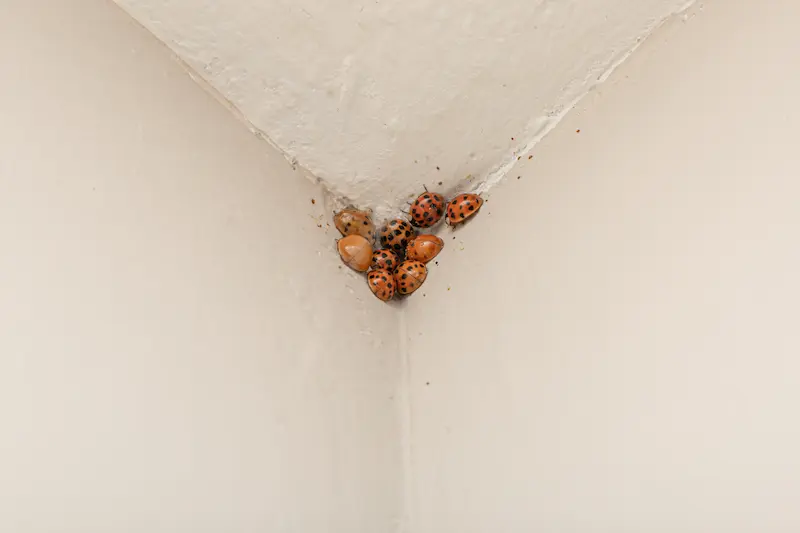As temperatures start to drop, you may notice more bugs crawling around or flying indoors. It’s not your imagination, many fall pests end up inside homes as they look for a warm place to wait out the cold weather.
While some pests burrow underground or migrate to warmer areas, others choose the comfort of your home. This seasonal behavior, known as overwintering, can lead to hidden infestations if it’s not addressed early.
Seeing an insect in your kitchen or living room is unpleasant enough, but the real trouble often lies with the ones hiding where you can’t see them. Typical fall invaders include Asian lady beetles, stink bugs, termites, wasps, rodents, and armyworms.
Asian Lady Beetles
If you’ve spotted what looks like an oversized ladybug, it’s probably an Asian lady beetle. These lookalikes can appear red, orange, or even yellow, with or without spots, and they often arrive in groups.
When disturbed or crushed, they release a foul-smelling yellow fluid that can stain fabrics, walls, and other surfaces. Some people may also experience mild allergic reactions, including eye or skin irritation. In rare cases, they can bite, causing minor discomfort.
Asian lady beetles use pheromones to alert others to safe shelter, meaning one beetle often leads to many more. To prevent an invasion, seal any exterior cracks, gaps, or openings where they could enter.
Stink Bugs
The Brown Marmorated stink bug, a common invasive pest from Asia, is the most frequent offender in U.S. homes. These shield-shaped insects are brownish-gray and give off a strong, lingering odor when threatened or crushed.
They prefer quiet, undisturbed spaces such as attics, crawl spaces, and wall voids, where they remain hidden throughout winter. Stink bugs can also damage houseplants as they feed, and their scent can linger if crushed indoors.
Dead stink bugs may even attract other pests like carpet beetles, so prevention and cleanup are extremely important.
Termites
Termites are easily among the most destructive pests in America, causing billions of dollars in damage annually. Unlike many fall pests, termites are active year-round, even when temperatures drop.
In cooler months, subterranean termites burrow deeper into the soil to stay warm, continuing to feed on wooden structures from below. They can quietly eat through floors, walls, and beams for months before being discovered.
Watch for warning signs like bubbling paint, hollow-sounding wood, or small pinholes on surfaces. Early detection could prevent the need for costly repairs, but left unchecked, these insects can cause immense structural damage.
Rodents
Mice, rats, and squirrels are all skilled climbers and can easily access your attic through vents, gaps, or overhanging branches. Once indoors, they chew through insulation and wires, contaminate food, and spread dangerous diseases such as hantavirus and salmonella.
You’ll likely hear scratching or gnawing inside your walls or ceiling if rodents move in. Don’t wait, these pests multiply quickly and can pose serious health and safety hazards.
Professional rodent control is the safest way to remove them and prevent future infestations.
Wasps
As fall approaches, worker wasps die off, but fertilized queens survive by seeking out safe winter shelters, like hollow trees, stumps, or even attic spaces.
If attic vents or roof gaps aren’t screened, wasps may slip inside and build new nests when spring arrives. Wasps are highly territorial, and their stings can be painful, or even life-threatening for those with allergies.
Have your attic and vents inspected to ensure all entry points are sealed and screened before cold weather sets in.
Armyworms
While armyworms don’t usually enter homes, they wreak havoc on lawns during late summer and early fall. These caterpillars feed in massive numbers, stripping grass down to the roots and leaving behind brown, patchy turf.
They’re especially active from September through October, and infestations can destroy entire lawns in just days. Early detection and prompt treatment are the only way to save your landscape.
How to Stop Fall Pests from Moving In
The best way to deal with pests is to prevent them from ever settling in. Take these proactive steps to keep your home pest-free this fall and winter:
- Seal gaps, cracks, and openings around windows, doors, and foundations.
- Install door sweeps and repair damaged screens.
- Keep shrubs and firewood away from your home’s exterior walls.
- Reduce clutter in attics and basements, and fix any moisture problems.
- Store all pantry items and pet food in airtight containers.
- Vacuum regularly to remove insects and debris.
- Schedule a professional pest inspection in early fall to identify vulnerabilities.
Trusted Experts for Fall Pest Control
If pests have already made their way inside, it’s time to call in the professionals. Twin Forks Pest Control® has been protecting homes from fall invaders for decades with eco-friendly, effective pest control services.Don’t wait until an infestation gets worse, contact Twin Forks Pest Control® today for expert pest removal and prevention solutions in Southold and Southampton.

